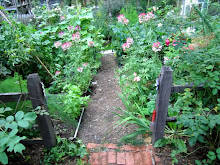"Page Dickey spent 30 years building the perfect garden. Now that she and her husband are in their 70s, cutting back is more of a priority." -Anne Raver, New York Times
Welcome to Heirloom Gardener
Tuesday, November 16, 2010
NYTimes: A Story about Gardening into your Seventies
Posted by
Julia Erickson
at
10:51 PM
1 comments
![]()
![]()
Labels: Deep Thoughts About Gardening, Fun Stories About Gardening
Friday, September 18, 2009
"In 1999, the Atlantic Monthly estimated that Borlaug's efforts...saved the lives of one billion human beings."
As readers of this blog know, I am a big fan of heirloom and organic gardening and food production, but know that in practice (my backyard), the yields are much lower. Thus, heirloom and organic food is a luxury that many in this country cannot afford and in most countries is non-existent. In that context, I found this obituary interesting, particularly the difference in agricultural development in Asia, where famine has been eliminated, and Africa, where famine continues to persist.
.
From Gregg Easterbrook's obituary on Norman Borlaug in The Wall Street Journal. For the full article click here.
'As a young agronomist, Borlaug helped develop some of the principles of Green Revolution agriculture on which the world now relies including hybrid crops selectively bred for vigor, and "shuttle breeding," a technique for accelerating the movement of disease immunity between strains of crops. He also helped develop cereals that were insensitive to the number of hours of light in a day, and could therefore be grown in many climates.
.
Green Revolution techniques caused both reliable harvests, and spectacular output. From the Civil War through the Dust Bowl, the typical American farm produced about 24 bushels of corn per acre; by 2006, the figure was about 155 bushels per acre.
.
Hoping to spread high-yield agriculture to the world's poor, in 1943 Borlaug moved to rural Mexico to establish an agricultural research station, funded by the Rockefeller Foundation. Borlaug's little research station became the International Maize and Wheat Center, known by its Spanish abbreviation CIMMYT, that is now one of the globe's most important agricultural study facilities. At CIMMYT, Borlaug developed the high-yield, low-pesticide "dwarf" wheat upon which a substantial portion of the world's population now depends for sustenance.
.
In 1950, as Borlaug began his work in earnest, the world produced 692 million tons of grain for 2.2 billion people. By 1992, with Borlaug's concepts common, production was 1.9 billion tons of grain for 5.6 billion men and women: 2.8 times the food for 2.2 times the people. Global grain yields more than doubled during the period, from half a ton per acre to 1.1 tons; yields of rice and other foodstuffs improved similarly. Hunger declined in sync: From 1965 to 2005, global per capita food consumption rose to 2,798 calories daily from 2,063, with most of the increase in developing nations. In 2006, the United Nations Food and Agriculture Organization declared that malnutrition stands "at the lowest level in human history," despite the global population having trebled in a single century.
.
In the mid-1960s, India and Pakistan were exceptions to the trend toward more efficient food production; subsistence cultivation of rice remained the rule, and famine struck. In 1965, Borlaug arranged for a convoy of 35 trucks to carry high-yield seeds from CIMMYT to a Los Angeles dock for shipment to India and Pakistan. He and a coterie of Mexican assistants accompanied the seeds. They arrived to discover that war had broken out between the two nations. Sometimes working within sight of artillery flashes, Borlaug and his assistants sowed the Subcontinent's first crop of high-yield grain. Paul Ehrlich gained celebrity for his 1968 book "The Population Bomb," in which he claimed that global starvation was inevitable for the 1970s and it was "a fantasy" that India would "ever" feed itself. Instead, within three years of Borlaug's arrival, Pakistan was self-sufficient in wheat production; within six years, India was self-sufficient in the production of all cereals.
.
After his triumph in India and Pakistan and his Nobel Peace Prize, Borlaug turned to raising crop yields in other poor nations especially in Africa, the one place in the world where population is rising faster than farm production and the last outpost of subsistence agriculture. At that point, Borlaug became the target of critics who denounced him because Green Revolution farming requires some pesticide and lots of fertilizer. Trendy environmentalism was catching on, and affluent environmentalists began to say it was "inappropriate" for Africans to have tractors or use modern farming techniques. Borlaug told me a decade ago that most Western environmentalists "have never experienced the physical sensation of hunger. They do their lobbying from comfortable office suites in Washington or Brussels. If they lived just one month amid the misery of the developing world, as I have for 50 years, they'd be crying out for tractors and fertilizer and irrigation canals and be outraged that fashionable elitists in wealthy nations were trying to deny them these things."'
Posted by
Julia Erickson
at
4:07 PM
3
comments
![]()
![]()
Labels: Deep Thoughts About Gardening
Tuesday, July 21, 2009
He was buried on his farm in a grove off a walking path he traversed each day
There's something wonderful and natural about the idea of home burial. From Katie Zezima in The New York Times:
"PETERBOROUGH, N.H. — When Nathaniel Roe, 92, died at his 18th-century farmhouse here the morning of June 6, his family did not call a funeral home to handle the arrangements.
.
Instead, Mr. Roe’s children, like a growing number of people nationwide, decided to care for their father in death as they had in the last months of his life. They washed Mr. Roe’s body, dressed him in his favorite Harrods tweed jacket and red Brooks Brothers tie and laid him on a bed so family members could privately say their last goodbyes.
.
The next day, Mr. Roe was placed in a pine coffin made by his son, along with a tuft of wool from the sheep he once kept. He was buried on his farm in a grove off a walking path he traversed each day."
For the full article, click here.
Posted by
Julia Erickson
at
10:43 PM
2
comments
![]()
![]()
Labels: Deep Thoughts About Gardening
Wednesday, May 27, 2009
Gardening and the Joy of Manual Labor: a Thought-Provoking Article by Matthew B. Crawford
One of the many pleasures of gardening is the joy that comes from manual labor and literally getting your hands dirty. When non-gardeners look at my garden and ask, "Isn't that a lot of work?" this particular pleasure is something that is not easily communicated nor understood. This is something that is not widely valued by our modern culture and therefore missing from many lives among both adults and children.
From The New York Times, "The Case for Working with Your Hands" by Matthew B. Crawford, adapted from his upcoming book, Shop Class as Soulcraft: An Inquiry Into the Value of Work:
"A gifted young person who chooses to become a mechanic rather than to accumulate academic credentials is viewed as eccentric, if not self-destructive. There is a pervasive anxiety among parents that there is only one track to success for their children. It runs through a series of gates controlled by prestigious institutions. Further, there is wide use of drugs to medicate boys, especially, against their natural tendency toward action, the better to “keep things on track.” I taught briefly in a public high school and would have loved to have set up a Ritalin fogger in my classroom. It is a rare person, male or female, who is naturally inclined to sit still for 17 years in school, and then indefinitely at work."
Related Post: Last Child in the Woods - Saving Our Children from Nature Deficit Disorder by Richard Louv
Posted by
Julia Erickson
at
9:47 PM
1 comments
![]()
![]()
Friday, April 17, 2009
More People Gardening, Canning, Sewing, and Focusing on Family in the Recession
Yes, the current economic crisis is awful, but here is some good news from Peggy Noonan's editorial in today's Wall Street Journal:
"A small sign of the times: USA Today this week ran an article about a Michigan family that, under financial pressure, decided to give up credit cards, satellite television, high-tech toys and restaurant dining, to live on a 40-acre farm and become more self-sufficient. The Wojtowicz family—36-year-old Patrick, his wife Melissa, 37, and their 15-year-old daughter Gabrielle—have become, in the words of reporter Judy Keen, "21st century homesteaders," raising pigs and chickens, planning a garden and installing a wood furnace.
Mr. Wojtowicz was a truck driver frustrated by long hauls that kept him away from his family, and worried about a shrinking salary. His wife was self-employed and worked at home. They worked hard and had things but, Mr. Wojtowicz said, there was a "void." "We started analyzing what it was that we were really missing. We were missing being around each other." ...
...The article offered data suggesting the Wojtowiczes are part of a recent trend. People are gardening more if you go by the sales of vegetable seeds and transplants, up 30% over last year at the country's largest seed company. Sales of canning and preserving products are also up. Companies that make sewing products say more people are learning to sew. I have a friend in Manhattan who took to surfing the Web over the past six months looking for small- and farm towns in which to live. The general manager of a national real-estate company told USA Today that more customers want to "live simply in a less-expensive place."
Posted by
Julia Erickson
at
10:56 PM
4
comments
![]()
![]()
Labels: Deep Thoughts About Gardening, Heirloom and Organic Food
Monday, October 20, 2008
Why Husbands Are (or Should be) Supportive of their Wives' Gardening Interests: "When She is Happy, He Is."
Here's something to think about. Megan Basham in the article "Who Wears the Pants" (October 10th) in The Wall Street Journal writes:
"In the past few years, stay-at-home moms have come under fire from some of feminism's most hard-line mouthpieces. These mothers have been told that they're letting down the sisterhood, endangering the economy and -- most important -- undermining their own position. By failing to bring in at least half the family income, it is claimed, they have rendered themselves powerless in their own homes...
But as it turns out, wives don't need income to wield power in their marriages. And mothers don't have much reason to fear losing power if they're not bringing home an equal share of the bacon. A Pew Research Center study released a couple of weeks ago found that when it comes to decision making in the home, wives in a majority of cases either rule the roost or share power equally with their husbands, regardless of how much money the women earn...
To be fair, many of the scholarly studies' conclusions include a 'final say' contingency -- many husbands claim that they have veto power when they feel very strongly about an issue. But consumer research shows that with the exception of what car to buy and when to buy it, men rarely claim strong enough feelings to override their wives...
The general consensus of sociologists is that, whereas a woman's marital satisfaction is dependent on a combination of economic, emotional and psychological realities, a man's marital satisfaction is most determined by one factor: how happy his wife is. When she is happy, he is (emphasis added). Working within this framework, most husbands are unwilling to dig in their heels on any issue unless they have a tremendous incentive to do so..."
Posted by
Julia Erickson
at
10:14 AM
1 comments
![]()
![]()
Labels: Deep Thoughts About Gardening
Wednesday, October 15, 2008
Blog Action Day 2008: Three Types of Poverty
As a part of Blog Action Day 2008 on Poverty, here are three thoughts:
1. Natural Poverty. Least importantly, but most related to gardening, I believe that there is a natural poverty related to our increasing disconnection from nature. From Last Child in the Woods by Richard Louv:
"Within the space of a few decades, the way children understand and experience nature has changed radically...Today, kids are aware of the global threats to the environment--but their physical contact, their intimacy with nature, is fading..."
2. Material Poverty. Most immediately, material poverty is increasing in all of our communities, which is particularly hurting the poorest of the poor. Our priest has noted that our local food pantries which are typically well stocked all week are currently running out of food on Mondays. His direction to us? Come to church each Sunday with a donation of food. In addition, two great organizations to support which serve the poorest of the poor in the New York-New Jersey and many other areas around the world are:
a. Franciscan Friars of the Renewal
b. Missionaries of Charity
3. Moral Poverty. As a big fan of Russian literature, I read with great interest the August obituaries written in memory of Alexandr Solzhenitsen. All mentioned the critique of the West delivered at Harvard on June 8, 1978. From the address:
"However, in early democracies, as in American democracy at the time of its birth, all individual human rights were granted because man is God's creature. That is, freedom was given to the individual conditionally, in the assumption of his constant religious responsibility. Such was the heritage of the preceding thousand years. Two hundred or even fifty years ago, it would have seemed quite impossible, in America, that an individual could be granted boundless freedom simply for the satisfaction of his instincts or whims.
Subsequently, however, all such limitations were discarded everywhere in the West; a total liberation occurred from the moral heritage of Christian centuries with their great reserves of mercy and sacrifice. State systems were becoming increasingly and totally materialistic. The West ended up by truly enforcing human rights, sometimes even excessively, but man's sense of responsibility to God and society grew dimmer and dimmer.
In the past decades, the legalistically selfish aspect of Western approach and thinking has reached its final dimension and the world wound up in a harsh spiritual crisis and a political impasse. All the glorified technological achievements of Progress, including the conquest of outer space, do not redeem the Twentieth century's moral poverty which no one could imagine even as late as in the Nineteenth Century (emphasis added)."
Posted by
Julia Erickson
at
10:07 PM
4
comments
![]()
![]()
Labels: Deep Thoughts About Gardening
Tuesday, August 05, 2008
"Children have lost touch with the natural world and are unable to identify common animals and plants," according to a UK survey
As a follow-up to my prior post on Richard Louv's book, Last Child in the Woods - Saving Our Children from Nature Deficit Disorder, the UK newspaker, The Independent, ran an article about a UK survey on the subject. Sadly, the journalist Sarah Cassidy reports:
"Half of youngsters aged nine to 11 were unable to identify a daddy-long-legs, oak tree...or bluebell, in the poll by BBC Wildlife Magazine. The study also found that playing in the countryside was children's least popular way of spending their spare time, and that they would rather see friends or play on their computer than go for a walk or play outdoors."
"Experts blamed the widening gulf between children and nature on over-protective parents and the hostility to children among some conservationists, who fear that they will damage the environment. They said that this lack of exposure to outdoor play in natural environments was vital for children's social and emotional development."
"Dr Martin Maudsley, play development officer for Playwork Partnerships, at the University of Gloucestershire, said that adults had become too protective of wild places: 'Environmental sensitivities should not be prioritised over children.'"
"He said: 'Play is the primary mechanism through which children engage and connect with the world, and natural environments are particularly attractive, inspiring and satisfying for kids. Something magical occurs when children and wild spaces mix.'"
Posted by
Julia Erickson
at
7:06 AM
6
comments
![]()
![]()
Labels: Deep Thoughts About Gardening, Gardening with Children
Thursday, July 10, 2008
A Book Worth Talking About: Last Child in the Woods - Saving Our Children from Nature Deficit Disorder by Richard Louv
First published in 2005 and re-published in 2008, I first heard about Last Child in the Woods by Richard Louv from another book, A Child's Garden by Molly Dannenmaier, which I read and enthusiastically reviewed last year. I'm reading it right now and would highly recommend it to anyone with children. From the introduction:
"Within the space of a few decades, the way children understand and experience nature has changed radically...Today, kids are aware of the global threats to the environment--but their physical contact, their intimacy with nature, is fading...
...This book explores the increasing divide between the young and the natural world, and the environmental, social, psychological, and spiritual implications of that change. It also describes the accumulating research that reveals the necessity of contact with nature for healthy child--and adult--development...
...Our society is teaching young people to avoid direct experience in nature. That lesson is delivered in schools, families, even organizations devoted to the outdoors, and codified into the legal and regulatory structures of many of our communities..."
An absurd example of this was written about in today's New York Times in the article "Build a Wiffle Ball Field and Lawyers Will Come," which reports on the local Greenwich, Connecticut backlash against a group of teenagers who turned an empty, town-owned lot into a miniature Fenway Park. The saddest quote comes from Jeff Currivan, 17: “They think we’re a cult...People think we should be home playing ‘Grand Theft Auto.’ ”
Posted by
Julia Erickson
at
10:52 PM
4
comments
![]()
![]()
Labels: Books and Movies, Deep Thoughts About Gardening, Gardening with Children
Search Heirloom Gardener
Labels
- About Blogging
- Annuals/Biennials and Perennials
- Autumn Garden
- Books and Movies
- Botanical Gardens
- Bulbs and Tubers
- Children's Garden
- Chrysanthemum
- Clematis
- Container Gardening
- Crocus tommasiniasus roseus
- Cut and Forced Flowers
- Cutting and Rose Gardens
- Dahlias
- Deep Thoughts About Gardening
- Egg Garden
- Fences Arbors Walls and Paths
- Floral arrangements
- Front Border
- Fun Stories About Gardening
- Garden Bloggers' Bloom Day
- Garden Bloggers' Design Workshop
- Garden Planning
- Gardening Blogs
- Gardening Tools and Structures
- Gardening with Children
- Goldberry Hill
- Heirloom and Organic Food
- Hibiscus
- Holidays
- Hydrangeas
- Japanese Beautyberry
- Lilies
- Mixed Borders
- New Jersey / Local Interest
- Nurseries
- Online Gardening Resources
- Peonies
- Pest Control
- Picture This Photo Contest
- Piet Oudolf
- Poppies
- Propagation and Seeds
- Pruning and Maintenance
- Roses
- Seed Heads
- Self Seeders
- Shrubs
- Spring Garden
- Summer Garden
- Trees
- Wildlife in the Garden
- Winter Garden
- Zinia















